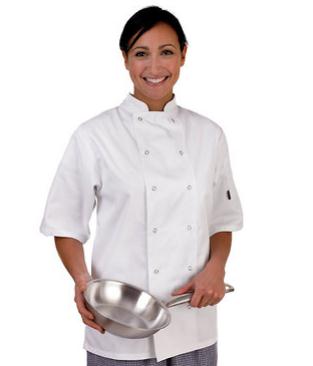A Buyer's Guide to the Chef's Jacket

The origins of the chef jacket or tunic are French, though there’s some disagreement as to when chef coats were first worn. Some say the story of the chef jacket starts with Napoleon, who reportedly asked that his chefs wear a jacket so that they looked more like soldiers. Here at Lockhart catering, we quite like this version of events, after all, a day spent in the kitchen can feel a lot like heading into battle. The incarnation of the white chef’s jacket that has become the classics style in the catering industry today is credited to popular French chef Marie Antoine Carême in the middle of the 19th Century. The design is thought to have been brought to the UK when Georges Auguste Escoffier came to London to manage the kitchens of the prestigious Savoy Hotel and Carlton Hotel.
Why do chefs wear a white chef jacket?
Why when the kitchen is a veritable danger zone for splashes and spills of all kinds are chefs’ jackets white? Well, in the modern kitchen the chef coat isn’t necessarily white; we sell black chef jackets that mask those spills a little better than their white counterparts. However, as any chef knows, the role of the chef is one of prestige and the white uniform has for many years been part and parcel of looking professional on the job. By wearing a white uniform the chef displays to customers that he, and by inference his kitchen, are clean and hygienic. In practice, keeping a chef’s jacket looking clean and white throughout a service is more than a little difficult, which is just one of the reasons why many chefs choose to wear a chef apron over their white chef coat.
How to measure for a chefs’ jacket/coat
Having a well-fitted chef jacket is not just a matter of looking professional it’s also about comfort and safety. Too tight a jacket will make that sweltering kitchen seem like an inferno and too loose will increase the probability of catching on cupboard doors or boiling liquids and oil spatters hitting your skin instead of a protective double layer of fabric. We sell chef jackets in sizes XS through to XXXL, which are sized by chest. To find out what size you’ll need, you should measure around the fullest part of the chest, positioning the tape under the arms and across the shoulder blades and keeping the tape level but not pulled too tight. When you receive your jacket, it should fit a little like a longer version of a traditional dress shirt, with four or five inches of extra fabric around your middle to allow for movement and comfort.
A guide to the features of your chef jacket
As well as helping you to look smart, each and every feature of your chef’s jacket is designed to assist you in your work. There are a few areas where you’ll have to make a choice based on what is best suited to your working style, personal preferences and your kitchen and also some additional features that you may want to look out for in order to increase your comfort levels. Here are the features and specifications to look out for:
- Double breasted – The double breasted nature of a chef jacket means it can easily be reversed to hide stains. It also incorporates a double layer of material, giving added protection from hot stoves or splashes.
- Dropped shoulder – A chef jacket usually features a slightly dropped shoulder, which gives a looser fit across the back, allowing for increased movability.
- Knotted cloth or studded buttons – The fastenings on chef coats are designed to work with the heat of the kitchen and allow you to remove the jacket quickly should you spill something hot on yourself. Traditionally chef buttons have been made of knotted cloth, which washes well. Studded buttons are another popular option and we sell designs that feature both types of fastening.
- Sleeves – For year round comfort, chef jacket sleeves come in long, short and three quarter lengths. Whether you choose a long-sleeved chef jacket or a short-sleeved chef jacket, the cuffs allow for breathability and can be rolled up or down when working on hot stations. The French cuff is a slightly more formal style that remains very popular.
- Reinforced and taped seams – To protect against chaffing in key areas such as under the arm, jacket seams are often taped or reinforced, which also promotes durability.
- Heavy but breathable fabric – There are a number of fabrics to choose from when selecting a chef jacket but the materials will usually be heavyweight with some degree of breathability, protecting you from the heat of stoves and pans while promoting comfort.
- White – If you do select a white tunic, you’ll be helping to moderate your temperature. As a colour, white repels heat, which is a useful feature in sweltering kitchens.
- Pen pocket – A lot of chef jackets have a pen pocket incorporated into one of the coat’s sleeves. This can be used to store a pen or other implements like a chef’s thermometer.

Polycotton versus Cotton
Chef jackets were traditionally made of cotton because of the breathability of the fabric, though now there are many more choices available. Here at Lockhart Catering, we sell cotton and polycotton chef jackets and each has their own merits, which should be matched to your individual preferences. Our chef jackets are made from:
- Poly cotton – A mix of polyester and cotton threads, polycotton is hardwearing, durable, and easy to launder and requires little to no ironing.
- Satin cotton – This is extremely high quality cotton with a luxury feel that offers good breathability. As such, it generally costs more and it can take a little more effort to maintain.
Keeping a chef jacket clean is most often an impossible task, even with the help of an apron. For hygiene reasons, most chefs change into their chef uniform – also known as chefs’ whites – at their restaurant. The venue or chef themselves may be responsible for laundering the garments, which therefore need to be able to withstand commercial laundering.
When washing a chef jacket, always follow the wash instructions on the care label and if possible, avoid tumble drying a jacket if stains haven’t been fully washed out as this can set a stain. Some chefs like to carry a detergent pen or stain remover wipes to catch quick spills before they stain, but again you should ensure these are compatible with the fabric. In recognition of the hard work that goes into maintaining a chef uniform, chefs in the UK are able to claim a tax rebate on the laundering and care of uniforms, so there’s no need to skimp on the softener!
Brigade Chef Clothing
All chef’s jackets on sale here at Lockhart Catering are manufactured by our own brand Brigade Chef Clothing. Brigade are experts in designing clothing for professional kitchen use and produce classic and contemporary items to suit different price points, kitchens and working styles. From budget options like these chef jackets through to the more luxury satin cotton chef jackets, which are perfect for chefs who make a regular appearance at the front of house, the Brigade chef uniform range is designed to make sure all of the fundamentals are covered, whatever your budget.
We hope that you have found this information useful in guiding you through the different options when purchasing a chef jacket. If you do have any questions that aren’t covered off within this guide, please don’t hesitate to get in touch. We’re always interested in hearing from our customers and would love to speak to you about your requirements.
Happy cheffing!





Leave a comment